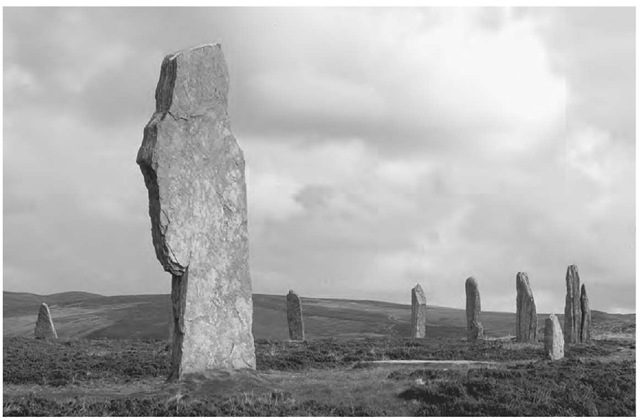The Ring of Brodgar is one of the most impressive, and one of the two most northerly, examples in Britain of a henge monument containing a stone circle. The stone circle is over 100 meters (330 feet) across, standing within a ditch over 120 meters (400 feet) in diameter (the outer bank has now almost completely disappeared). Several of the stones rise to a height of over 3 meters (10 feet). Located on the largest of the Orkney Islands (Mainland Orkney) off the northern coast of Scotland, it occupies a magnificent situation toward the end of a long, narrow isthmus projecting into a large freshwater lake (the lochs of Harray and Stenness). Just 1.5 kilometers (1 mile) away are the even taller Stones of Stenness, another henge and stone circle in a matching situation: Stenness occupies a shorter isthmus on the other side of a 200 meters (700 feet) gap that one can now cross by a road bridge. The Ring of Brodgar was clearly of paramount importance in the prehistoric landscape in around 3000 b.c.e., when it was probably constructed. Standing sentinel over what was almost certainly an important route across the island, and clearly visible from all around, it occupied a position of great power and influence. That it remained a conspicuous ancestral monument revered for many generations seems evident from the numerous round cairns that were built around it in the Bronze Age, more than a millennium later.
The Ring of Brodgar, Orkney Islands, Scotland.
The site achieved astronomical notoriety in the 1970s when Alexander Thom and his son Archie first published the theory that it was a sophisticated lunar observatory. According to the Thoms, various alignments at the site, mostly between the outlying cairns, were deliberately aligned upon horizon foresights that marked limiting rising and setting positions in the moon’s complex cycles. So precise were the alleged alignments—to less than two arc minutes—that the Thoms were forced to conclude that programs of observation lasting many generations must have been needed.
The Ring of Brodgar, more than any other single monument, demonstrates the dangers of over-enthusiastic interpretation in archaeoastronomy. Time has dealt harshly with the “lunar observatory” hypothesis. The problem lies in the selection of data: the selection of alignments, the selection of foresights, and the selection of lunar “targets” deemed significant are all highly questionable. The four foresights, for example, are of varying degrees of conspicuity, varying from the crest of the impressive distant cliffs of Hel-lia 13 kilometers (8 miles) away on the island of Hoy, down to an almost imperceptible blip on the horizon at a place called Ravie Hill. There is no reason (other than their lunar potential) to pick out the four chosen from the many dozens, if not hundreds, of other possibilities.
Above all, the example of Brodgar shows the paramount importance of a field methodology that ensures the fair selection of data and its critical assessment. It is all too easy, even for a professional academic working outside his or her own discipline, to end up—unwittingly—merely picking out the evidence that seems to support a favored theory while ignoring the rest.

